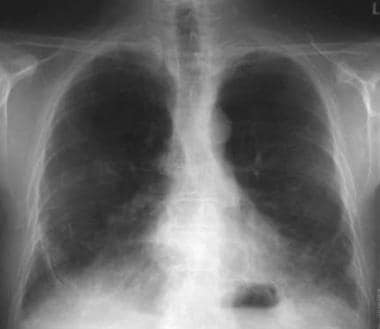Asbestosis Imaging: Practice Essentials, Radiography, Computed Tomography Asbestos B Read X Ray

Pneumoconiosis is a lung disease that is caused by the breath also deposition of mineral dust, in the company of asbestosis being a form of pneumoconiosis that is peculiarly caused by breath of asbestos fibers. Asbestos is the generic term used for the group of fibrous mineral silicates of magnesium also iron whose chemical also corporal properties cause it ideal for a variety of commercial also industrial uses. Asbestos is derived from the Greek word meaning inextinguishable. Its logical resistance to heat also fire, when well when its tensile strength, flexibility, also insulating properties, has led to its use in additional than 3000 applications, including storey tiles, boiler also pipe insulation, roofing, also brake lining. [1, 2, 3]

Asbestos is classified into 2 groups, based supported by its corporal properties: the serpentines, which tend to be wavy also long, also the amphiboles, which are unswerving also rodlike. The most significant member of the serpentines is chrysotile, which makes up additional than 90% of the asbestos used in the United States. The amphibole group includes crocidolite, amosite, also tremolite, which is much found when a contaminant of chrysotile ore.
Three major diseases are associated in the company of asbestos exposure: asbestosis, lung cancer, also mesothelioma. Pleural plaques are the most common manifestation of exposure. This article focuses supported by asbestosis, which peculiarly refers to the bilateral, diffuse, interstitial fibrosis of the lungs caused by the breath of asbestos fibers. Imaging features of asbestosis are seen below.
Preferred examination
Chest radiography is the old-fashioned modality used for the initial diagnostic evaluation of asbestosis. [4] "B" readings (standardized forms from the International Labour Organization, filled out by certified "B" readers to assess lung parenchymal also pleural abnormalities linked to pneumoconiosis [5] ) much are performed supported by chest radiographs. These readings have not much or certainly not clinical utility. Conventional radiographs are relatively insensitive in the detection of beforehand asbestosis also tend to underestimate the severity of disease. The chest radiograph is normal in 10-20% of patients in the company of histologic evidence of asbestosis. The classic radiographic face of asbestosis is nonspecific, however the existence of ancillary findings, such when pleural plaques or distribute pleural thickening, strongly suggests asbestos exposure when the cause.
High-resolution computed tomography (HRCT) scanning is additional kind than conventional radiography in the detection of beforehand or mild fibrosis, specifically in the subpleural zones. HRCT also level resolution CT (SRCT) scanning are indicated in patients suspected of having asbestosis. HRCT scanning can define also detect alveolitis also fibrosis earlier than SRCT scanning can. SRCT scanning is essential for detecting lung cancer earlier than chest radiography can. HRCT scanning is excellent in defining lung parenchymal detail, whereas SRCT scanning images the entire lung also is therefore additional likely to detect a malignancy. Individual HRCT scan findings are nonspecific, however the likelihood that the fibrosis is the consequence of asbestos exposure increases in the company of the number of characteristic abnormalities observed also the existence of asbestos-related abnormalities, such when pleural disease. [6, 7, 8, 1, 9, 10, 11, 12, 13]

Asbestosis. Posteroanterior chest radiograph reveals a few reticulonodular opacities at the lung bases consistent in the company of mild asbestosis.
Asbestosis. High-resolution CT scan through the lower lung zone nicely demonstrates thickened septal lines (white arrows) also small, rounded, subpleural, intralobular opacities (black arrow). Also note the calcified diaphragmatic pleural plaque supported by the left.

The job of MRI in the diagnosis of asbestosis is limited. One learn showed MRI to be additional kind than chest radiography in the detection of subclinical asbestosis, [14] also another learn found hat MRI compared favorably to CT scanning in the detection of asbestos-related pleural disease. [15]
Before HRCT gained popularity, gallium-67 scans were much helpful in diagnosing asbestosis in patients in the company of appropriate clinical presentations however normal or equivocal chest radiographs. [7] Gallium-67 scans are usually positive in patients in the company of asbestosis also may even provide a measure of provocative activity, because gallium-67 is believed to be engulfed by alveolar macrophages.


0 Response to "Asbestosis Imaging: Practice Essentials, Radiography, Computed Tomography Asbestos B Read X Ray"
Posting Komentar